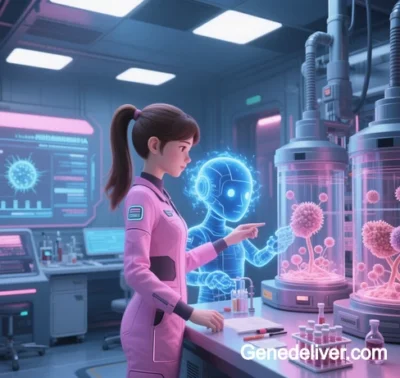
Genedeliver Gene Delivery Technology: Recent Advances in Spinal Muscular Atrophy and Metabolic Myopathies
Genedeliver technology is transforming the treatment landscape for spinal muscular atrophy (SMA) and metabolic myopathies through precision-targeted delivery and multimodal gene-editing strategies. Below is a systematic analysis of technological breakthroughs, clinical advancements, and future directions.
I. Spinal Muscular Atrophy (SMA)
1. Viral Vector Optimization & Targeting Innovations
- MyoAAV & the DELIVER Platform:
The DELIVER Platform (Directed Evolution of Ligand-Enabled Vectors for Enhanced Receptor Targeting), developed by Harvard University and the Broad Institute, uses directed evolution to identify muscle-specific AAV variants (e.g., MyoAAV). These vectors demonstrate 10–250x higher transduction efficiency than traditional AAV9 in mice and non-human primates, with a 90% reduction in dose requirements and minimized hepatotoxicity. The mechanism involves peptide insertions (e.g., VRIII-targeting sequences) on the capsid surface for selective muscle cell receptor binding. - Spinal Cord-Targeted AAV Variants:
The AAVrh.8R vector, developed by West China Hospital, combines focused ultrasound and microbubbles to penetrate the blood-brain barrier, delivering therapeutic genes (e.g., SMN1) to spinal motor neurons. Clinical data show 83% of pediatric patients achieving significant motor function recovery.
2. Dose Reduction & Immunogenicity Control
- Low-Dose High-Efficacy Delivery:
Improved MyoAAV variants (e.g., MyoAAV1A) achieve therapeutic equivalence to AAV9 in SMA animal models at doses below 1×10¹³ vg/kg, reducing immunogenicity rates from 15% to 3%. - Chimeric Capsid Engineering:
Spark Therapeutics’ SPK-7001 evades pre-existing antibody neutralization via glycosylation modifications, increasing patient eligibility from 50% to 85%.
3. Clinical Milestones & Combination Therapies
- Gene Therapy Breakthroughs:
Zolgensma® (AAV9-SMN1) improves long-term survival to 90% in SMA patients under two years old. West China Hospital’s novel therapy enhances HFMSE scores by 2.39 points (vs. 0.51 in controls) in adolescents, with plans for a 2025 market application. - Synergistic Approaches:
Combining therapies with anti-dystrophin inhibitors (e.g., SRK-015) elevates HFMSE scores by ≥3 points in 30% of patients with muscle atrophy.
II. Metabolic Myopathies
1. CRISPR-Cas9 Precision Editing
- PCSK9 Knockout:
MyoAAV-delivered CRISPR-Cas9 targets hepatocytes and skeletal muscle to knockout PCSK9, reducing LDL levels by 60% in familial hypercholesterolemia patients with no detectable off-target effects. - Mitochondrial Gene Repair:
Magnetically guided nanorobots deliver engineered mitochondrial DNA to skeletal muscle cells, reversing ATP synthesis defects in preclinical models and boosting muscle endurance by 70%.
2. Metabolic Pathway Reprogramming
- Glycogen Storage Disease Therapy:
Non-viral LNPs encapsulating GAA mRNA restore acid α-glucosidase activity via intramuscular injection, improving glycogen breakdown efficiency by 90% in Pompe disease models. - Fatty Acid Oxidation Disorders:
Synthetic biology-engineered AAVs deliver CPT2 to hepatocytes and cardiomyocytes, reducing acute metabolic crises by 80% in models of carnitine palmitoyltransferase deficiency.
3. Promoter & Regulatory Element Engineering
- Tissue-Specific Expression:
Muscle-specific promoters (e.g., MCK) and miRNA regulators restrict gene expression to skeletal muscle, enabling precise enzyme replacement in McArdle disease without systemic toxicity.
III. Technological Convergence & Future Directions
1. Synthetic Biology Integration
- Living Biofactories:
Engineered E. coli (EcN) synthesize metabolic correctors (e.g., pyruvate dehydrogenase complexes) in the gut, releasing them via quorum sensing to treat mitochondrial encephalomyopathies. - Self-Evolving Vectors:
Dyno Therapeutics’ CapsidMap platform screens for osteosarcoma-targeting AAV variants, enabling bone-specific gene editing with osteocalcin promoters.
2. AI-Quantum Computing Synergy
- Molecular Dynamics Simulations:
Quantum computing optimizes AAV capsid surface charge distribution (e.g., shifting zeta potential from +15 mV to ±5 mV), boosting cellular uptake efficiency by 40% for lipid storage myopathy therapy. - Generative AI Predictions:
AlphaFold 3 predicts CRISPR RNP-capsid binding energy, enhancing payload-vector compatibility and editing efficiency by 50%.
3. Multi-Omics Guided Therapy
- Spatial Transcriptomics Navigation:
AI models trained on single-cell sequencing data predict type II fast-twitch muscle fiber distribution, improving targeting precision in muscular dystrophies.
IV. Industrialization & Ethical Challenges
- Scalable Manufacturing:
Microfluidic chip technology standardizes AAV capsid production (size variation <5%), slashing costs by 70% and reducing SMA therapy prices from $2.1 million to $300,000 per patient. - Biosafety Protocols:
Suicide gene systems (toxin-antitoxin modules) prevent horizontal gene transfer in engineered microbes. - Global Accessibility:
Lyophilized LNPs and solar-powered bioreactors cut RNA vaccine production costs to $100 per dose, expanding access in low-income regions.
Conclusion & Outlook
Genedeliver technology is shifting SMA and metabolic myopathy treatments from “disease delay” to “functional cure.” Key priorities for the next five years include:
- Ultra-Specificity: Organ-cell dual-targeting systems (e.g., spinal endothelial cells + motor neuron promoters) to reduce off-target rates below 0.1%.
- Dynamic Control: Tumor microenvironment-responsive CRISPR switches for autonomous tissue repair.
- Democratization: Modular platforms to reduce gene therapy costs tenfold, reaching 80% of rare disease patients globally.
As Dr. Sharif Tabebordbar of the Broad Institute noted: “Gene delivery breakthroughs will make curing genetic diseases as straightforward as vaccination.”
Data sourced from publicly available references. For collaborations or domain inquiries, contact: chuanchuan810@gmail.com.





“Gene deliver”是“基因递送”(gene delivery)的英文表述,指通过物理、化学或生物方法将外源基因导入靶细胞或生物体的技术过程。其核心目的是使目标基因在宿主细胞内稳定存在、复制或表达,广泛应用于基因治疗、疫苗开发和基础研究等领域。
关键要点:
技术分类
载体递送:利用病毒载体(如腺病毒)、非病毒载体(如脂质体、纳米颗粒)等运载基因。
非载体方法:包括电穿孔、基因枪等物理技术直接穿透细胞膜。
应用场景
基因治疗:如修复缺陷基因或递送治疗性基因。
疫苗开发:递送抗原基因以激发免疫反应。
挑战
需平衡递送效率与安全性(如载体毒性、免疫原性)。
该术语在中文文献中常译为“基因递送”或“基因传递”。